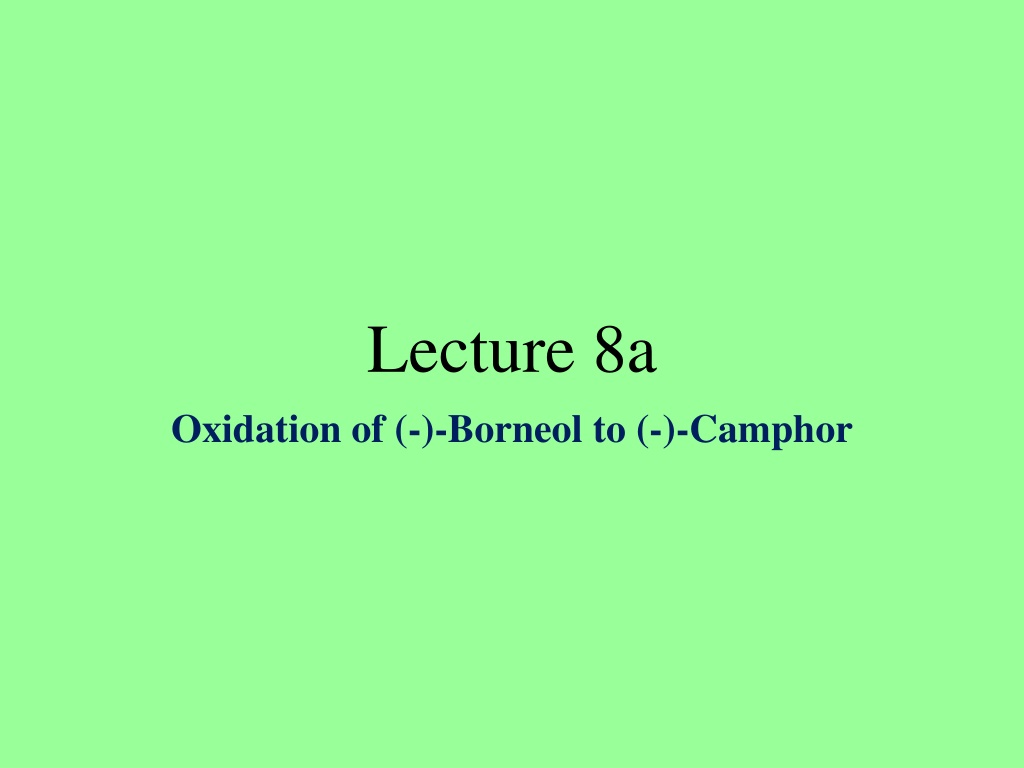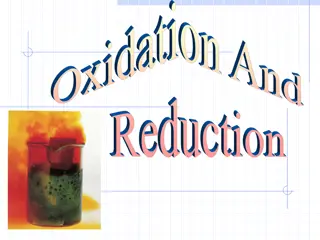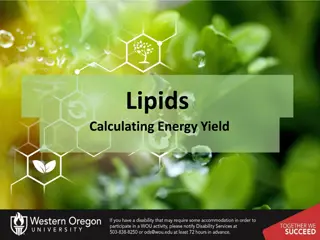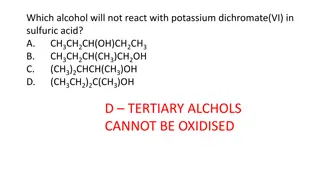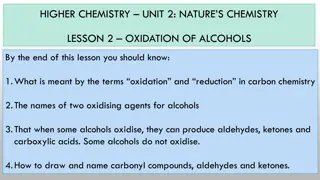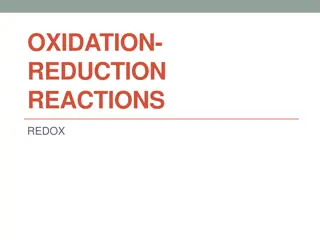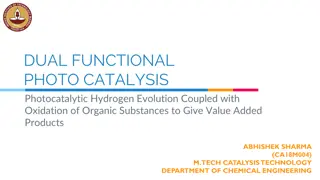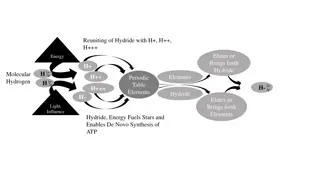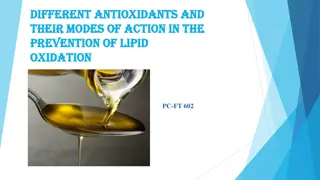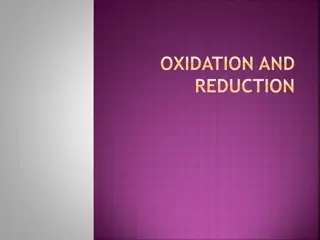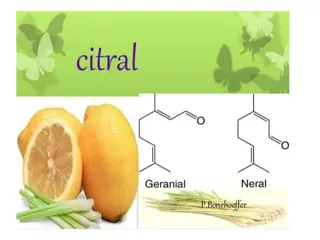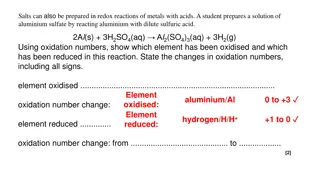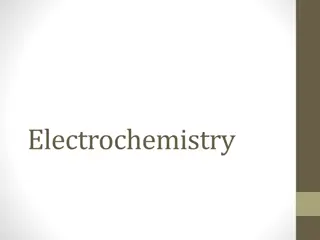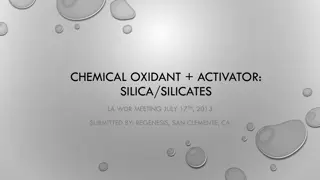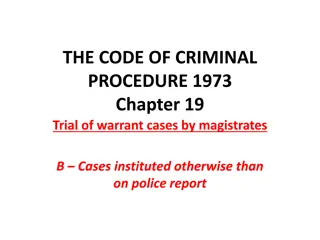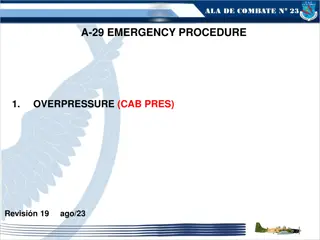Oxidation of (-)-Borneol to (-)-Camphor: Experimental Procedure
The experiment details the oxidation of (-)-borneol to (-)-camphor using hypochlorous acid, along with purification steps. It involves the use of household bleach solution and various testing methods to ensure successful conversion. The process includes handling small amounts of reagents, monitoring reactions, and confirming the presence of key chemical components. Proper technique and attention to detail are emphasized throughout the procedure.
Uploaded on Oct 10, 2024 | 0 Views
Download Presentation

Please find below an Image/Link to download the presentation.
The content on the website is provided AS IS for your information and personal use only. It may not be sold, licensed, or shared on other websites without obtaining consent from the author. Download presentation by click this link. If you encounter any issues during the download, it is possible that the publisher has removed the file from their server.
E N D
Presentation Transcript
Lecture 8a Oxidation of (-)-Borneol to (-)-Camphor
Introduction Camphor is a terpenoid that can be isolated from camphor laurel (picture on the right shows the leaves of a tree on GayleyAvenue), the kapur tree, camphor basil or rosemary leaves. In biosynthesis, it is obtained from geranyl pyrophosphate via cyclization. The hydrolysis of bornyl pyrophosphate and the oxidation of borneol affords D-(+)-camphor. Industrially, it can be obtained from -pinene by two rearrangements reactions. The hydrolysis of the isobornyl acetate leads to borneol that is oxidized to form racemic camphor.
Oxidation in Organic Chemistry The following experiment illustrates the oxidation of a secondary alcohol to a ketone. This could be accomplished using different oxidants, i.e., oxone (KHSO5), dichromate, PCC, oxalyl chloride/DMSO (Swern oxidation). In this course, hypochlorous acid (HOCl) is used. It obtained from the reaction of hypochlorite (from bleach) and acetic acid. OCl- + CH3COOH HOCl + CH3COO-
Oxidation of (-)-Borneol The oxidation of (-)-borneol with hypochlorous acid results in the formation of (-)-camphor. The crude product is purified by sublimation.
Experimental I Dissolve (-)-borneol in glacial acetic acid in a 25 mL Erlenmeyer flask with swirling at room temperature Add fresh household bleach solution in one batch with swirling The solution will become noticeably warm and the product will precipitate. Why do we use such a small flask? Handling small amount of material What is household bleach? Bleach is a solution of 5.25 % NaOCl (0.7 M NaOCl) Why does the reaction warm up? The reaction itself is exothermic
Experimental II Over the next 15 minutes swirl the mixture occasionally Test the sample after 10 minutes by placing a drop on wet potassium iodide-starch paper. Dilute the reaction mixture with water and transfer it to a separatory funnel with the help of some diethyl ether. A blue color indicates excess hypochlorite because an triiodide- starch complex was formed. File:KI test paper.jpg If the test is negative, add a small amount (~0.5 mL) of additional hypochlorite solution and swirl. After 5 minutes, test again.
Experimental III Add some saturated sodium bisulfite solution and shake the mixture for at least 20 seconds before draining the lower layer. Wash the organic layer with about 8 mL of saturated sodium bicarbonate solution. Make sure to vent frequently. What does the bisulfite do? It reduces the excess of the hypochlorous acid. Why is it important to vent frequently? The reaction of the acetic acid with the bicarbonate results in the formation of carbon dioxide. Make sure that the aqueous layer is basic. If neutral or acidic, this step has to be repeated with sodium bicarbonate solution.
Experimental IV Drain off the lower aqueous layer, and transfer the organic layer to a small, dry Erlenmeyer flask. Rinse the separatory funnel with some diethyl ether. Dry the combined organic solutions over a small amount of anhydrous sodium sulfate (Na2SO4). How is this done? By removing the plug on the top and open the stopcock on the bottom How do we know that the solution is dry? 1. Some free flowing drying agent 2. A transparent solution
Experimental V Clean your filter flask if necessary with a small amount of acetone. Do not clean it with water. Make sure the filter flask is dry and clean before you transfer the dried organic layer to it. Why not cleaning with water? The flask has to be very dry. Why do we pre-weight the flask? Pre-weigh the flask . It will be easier to determine the crude yield of camphor. Be sure to record this weight in your notebook Decant the dry organic layer from the drying agent directly into the clean, filter flask. You will use the same filter flask for the sublimation in the next step of the assignment. There are two procedures for evaporating the diethyl ether without losing the product work well. Consult the teaching assistant as to which one you should use. Either vacuum or air stream
Experimental VI Using a small spatula, consolidate the crude in the center of the filter flask so that it will be just underneath the cold-finger test tube (see diagram). Attach the test tube cold finger and tightly position it in the neck of the flask. Do not place water in the tube, yet. Position the bottom of the test tube 0.5-1 cm above the crude product minimizing the gap but not touching the crude. Wrap a piece of aluminum foil around the side of the flask leaving an opening at the front so that you can watch the progress of the sublimation. This will minimize the amount of product that sublimes on to the sides of the flask. Place a small amount of crude in a vial for reserve in case no product is isolated after the sublimation.
Experimental VII Place the sublimation setup on a hot plate and turn the heat on low (1-2). Heat the flask only very gently. Place the ice in the test tube being careful to not let any water run down the outside of the tube and into the flask. Carefully remove the cold finger and quickly scrape the sublimed product onto a weighing paper, watch glass or pre-weighed vial. Determine the yield of the sublimed product. Save the sublimed product in a vial. Why do we use such a low setting? Camphor is very volatile. Higher temperatures make it difficult to deposit. Why do we not have water in the system? Any water that runs down the cold-finger make the product wet and can cause the filter flask to crack.
Characterization I Borneol (KBr) (OH)=3200-3400 cm-1 (C-OH)=1055 cm-1 (strong) (OH) (C-OH) Camphor (KBr) (C=O)=1744 cm-1 (C=O)
